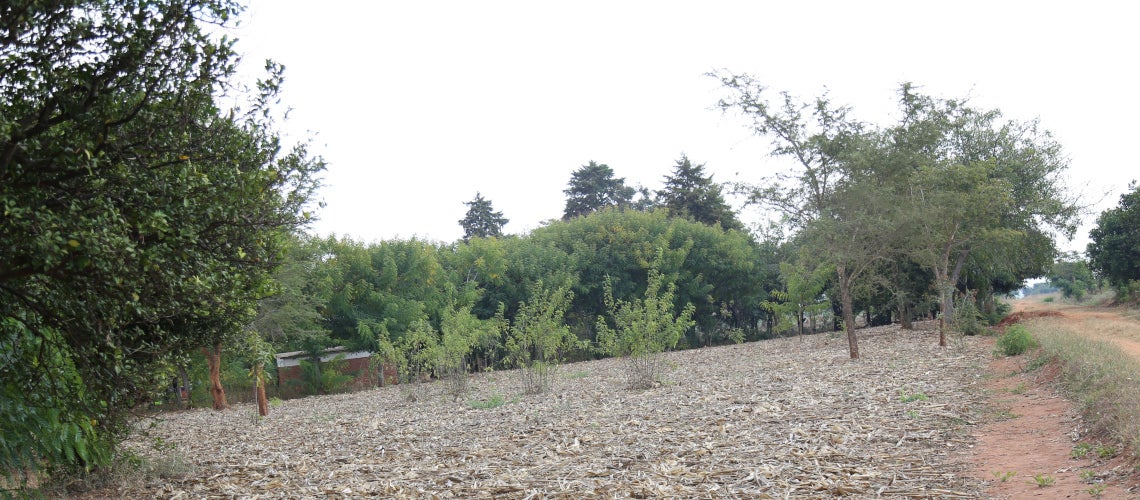 Mulching and agroforestry are examples of climate-smart agriculture. Photo credit: Henry Chimbali/World Bank
Mulching and agroforestry are examples of climate-smart agriculture. Photo credit: Henry Chimbali/World Bank
Growing up in the most southern tip of Malawi, I remember my ancestors practicing zero tillage, intercropping maize with pigeon peas, green beans, pumpkins and more. Later, these were characterized as “uncivilized” ways of farming, and they then adopted “civilized” techniques, such as heavy tillage, ridges and mono-cropping. Meanwhile these approaches have caused notable problems in agricultural ecosystems as experienced by most farmers. Later in life, we learn now that agriculture needs to embrace the same approaches as my ancestors did in the name of Climate-Smart Agriculture (CSA). Are we back from where we started?
Agriculture is critical for Malawi, not only for food security but also as a major source of economic growth. It contributes about 30% of the country’s gross domestic product (GDP), and supports the livelihood of approximately 15 million; 80% of the population. But traditional forms of agriculture that rely on very little external inputs such as improved seeds and fertilizers are unsustainable, deplete soil nutrients, and accelerate soil erosion. Poor agricultural practices, combined with increasingly unreliable rainfall have left farmers with low crop yields, rampant food shortages, and meager incomes, leading to other poor developmental outcomes.
To address these problems, the Comprehensive Africa Agriculture Development Programme (CAADP) 2015-2035 looks forward to the enhancement of livelihoods and production systems to be more resilient to climatic variabilities and other shocks. In line with CAADP, the Ministry of Agriculture and Food Security is leading the scaling up of CSA in the country through the World Bank-supported Multi-Donor Trust Fund Agriculture Sector Wide Approach-Supporting Project II (ASWAp-SP). ASWAP-SP promotes CSA for two main objectives. The first objective to enhance resilience of farmers due to increasing and persistent droughts. The second objective is to improve soil health for increased agricultural productivity. So far, approximately 140,000 farmers have adopted a range of CSA practices including cover crops, intercropping, crop rotation, composting, and agroforestry. The project has improved the soil health of nearly 28,000 ha and fostered agroforestry on 42,000 ha of agricultural land.
Farmers who have adopted CSA practices have increased their resilience to erratic climatic conditions and their impact, enabling them to attain food security amid difficult situations. It’s also led to increased yields and income, allowing farmers to meet other needs and resulting in improved livelihoods.
CSA adoption also has long term benefits, as it continuously improves soil health for improving agricultural productivity, and that in turn increases the ability to recover from extreme weather shocks. But despite the evident benefits, the adoption of CSA technologies faces several socioeconomic and institutional barriers in Malawi. These include uncoordinated policies and strategies within the agriculture sector, continuous use of traditional agricultural tools, inadequate knowledge and skills for CSA technologies, and failure to explore and tap from digital technologies.
So how best, can Malawi build a more climate-smart agriculture and food system? First, there is benefit in harmonizing policies and approaches that encourage the adoption of CSA. The absence of harmonized policies results in uncoordinated approaches on how to engage beneficiaries who end up being confused by information from different stakeholders. Promotion of approaches such as the 4Fs concept in agroforestry--which fosters planting of fertilizer, fruits, fodder and fuel trees—is an example that demonstrates harmonization of existing policies.
Second, it is important to build capacity for CSA implementation. The priorities in this area include strengthening research through partnerships with international research institutes, which can help to develop high-yielding, stress-tolerant, climate-ready varieties. Farmers will need to upgrade their knowledge of extension agents with agricultural innovation and CSA practices, facilitate sharing CSA techniques, and provide support to local and indigenous knowledge systems. World Bank-supported Agricultural Productivity Program for Southern Africa provided a very good starting point by developing and promoting drought resistant varieties.
Third, integrating agricultural mechanization by developing and adapting locally appropriate machinery and farm power in collaboration with the private sector will spark ownership among farmers. The government can promote private ownership of agricultural machinery and farm power and incentivize the development of farmer-to-farmer service-hiring markets to meet growing demand of mechanization services from smallholders.
Finally, leveraging digital technologies to promote on-farm efficiency, environmental sustainability and financial and market inclusion is fundamental. The priorities here are the deployment of digital platforms that will respond to farmers’ needs, provide accurate information, be easy to use, affordable and be easily accessible to farmers.
Scaling up climate-smart agriculture in Malawi is vital to ending hunger and boosting shared prosperity sustainably. The ASWAp-SP is an important first step which stakeholders can build upon for sustainable agricultural transformation in the country.


Join the Conversation